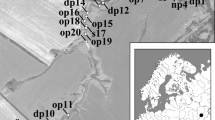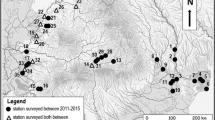Abstract
An analysis of mollusc communities collected at 272 stations was carried out, using multivariate statistical methods. The stations ranged from the sources to the lower reaches of large rivers. Nine malacotypes succeeded each other along this upstream-downstream gradient; comments are given regarding the composition of their communities. The organisation of the 52 mollusc species included corresponds to that of a theoretical river, representative of the French hydrographic system. The reduction of the abundance and of species richness in the lower reaches of large rivers is discussed.
Similar content being viewed by others
References
Benzecri, J. P. et Coll., 1976. L'analyse des données.-L'analyse des correspondances. Dunod, Paris: 616 pp.
Boycott, A. E., 1936. The habitats of freshwater molluscs in Britain. J. anim. Ecol. 5: 116–136.
Bravard, J. P., C. Amoros & G. Pautou, 1986. Impact of civil engineering works on the successions of communities in a fluvial system. Oikos 47: 92–111.
Falniowski, A., 1980. The anatomical determination of Polish Lymnaeidae (Mollusca, Basommatophora). Acta hydrobiol. 22: 327–335.
Fittkau, E. J. & F. Reiss, 1983. Versuch einer Rekonstruktion der Fauna europäischer Ströme und ihrer Auen. Arch. Hydrobiol. 97: 1–6.
Foeckler, F., 1991. Classifying and evaluating alluvial flood plain waters of the Danube by water mollusc associations. Verh. int. Ver. Limnol. 24: 1881–1887.
Foeckler, F., U. Diepolder & O. Deichner, 1991. Water mollusc communities and bioindication of lower Salzach floodplain waters. Regul. Riv. 6: 301–312.
Germain, L., 1931. Mollusque terrestres et fluviatiles. in Lechevalier (ed.), Faune de France. Librairie de la Faculté des Sciences Paris, 21–22: 897 pp.
Guinochet, M., 1973. Phytosociologie. Masson, Paris. 277 pp.
Hynes, H. B. N., 1986. Foreword in B.R. Davies & K.F. Walker (eds), The Ecology of River Systems. Dr W. Junk Publishers, Dordrecht: VII-X.
Illies, J. & L. Botosaneanu, 1963. Problèmes et méthodes de la classification et de la zonation écologique des eaux courantes, considérée surtout du point de vue faunistique. Mitt. int. Ver. Limnol. 12: 1–57.
Jeffries, M & D. Mills, 1990. Freshwater Ecology: principles and applications. Belhaven Press, London, 285 pp.
Kuiper, J. G. J., 1966. La distribution des espèces vivantes du genre Pisidium C. PF. en France. J. Conchyl. 105: 181–215.
Kuiper, J. G. J., 1982. Zur Frage der geographischen Unterarten bei Pisiden, insbesondere bei Pisidium personatum Malm. Arch. Moll. 112: 9–19.
Meier-Brook, C., 1975. Der ökologische Indikatorwert mitteleuropäischer Pisidium Arten (Mollusca, Eulammellibranchiata). Eiszeitaler Gegenwart. 26: 190–195.
Mouthon, J., 1980. Contribution à l'écologie des mollusques des eaux courantes. Esquisse biotypologique et données écologiques. Thèse 3e cycle, Univ. Paris VI, 169 pp.
Mouthon, J., 1981. Typologie des mollusques des eaux courantes. Organisation biotypologique et groupements socioécologiques. Ann. Limnol. 17: 143–162.
Mouthon, J., 1996. Molluscs and biodegradable pollution in rivers: proposal for a scale of sensitivity of species. Hydrobiologia 317: 221–229.
Obrdlik, P., G. Falkner & E. Castella, 1995. Biodiversity of Gastropoda in European floodplains. Arch. Hydrobiol. Suppl. 101: 339–356.
Richardot-Coulet, M., E. Castella & C. Castella, 1987. Classification and succession of former channels of three French Upper Rhône alluvial plain using Mollusca. Regul. Riv. 1: 111–127.
Smol, J. P., 1995. Paleolimnological approaches to the evaluation and monitoring of ecosystem health: providing a history for environmental damage and recovery. In Rapport D. J., C. L. Gaudet & P. Calow (eds), Evaluating and Monitoring the Health of Large-Scale Ecosystems. Springer-Verlag, Berlin: 16: 301–318.
Verneaux, J., 1973. Cours d'eau de Franche-Comté (Massif du Jura)-recherches écologiques sur le réseau hydrographique du Doubs. Essai de biotypologie. Thèse Doct. Sci. nat., Univ. Besançon, 257 pp.
Verneaux, J., 1976 a. Biotypologie de l'écosystème “eau courante”. La structure biotypologique. C. r. Acad. Sci., Paris 283: 1663–1666.
Verneaux, J., 1976 b. Biotypologie de l'écosystème “eau courante”. Les groupements socio-écologiques. C. r. Acad. Sci., Paris, 283: 1791–1793.
Verneaux, J., 1977. Biotypologie de l'écosystème “eau courante”. Détermination approchée de l'appartenance typologique d'un peuplement ichtyologique. C. r. Acad. Sci., Paris 284: 675–678.
Verneaux, J., 1981. Les poissons et la qualité des cours d'eau. Ann. sci. Univ. Besançon 4: 33–41.
Verneaux, J., 1994. Le macrobenthos et “l'état de santé” des eaux douces-Fondements, contraintes et perspectives. In les variables biologiques: des indicateurs de l'état de santé des écosystèmes aquatiques. Sémin. nat. 2 et 3 nov. 1994, Paris: 1–17.
Walker, I. R., 1993. Paleolimnological biomonitoring using freshwater benthic macroinvertebrates in D.M. Rosenberg & V.H. Resh (eds), Freshwater Biomonitoring and Benthic Macroinvertebrates. Chapman & Hall, NY: 306–343.
Ward, J. V. & J. A. Stanford, 1995. Ecological connectivity in alluvial river ecosystems and its disruption by flow regulation. Regul. Riv. 11: 105–119.
Willmann, R. & H. Pieper, 1978. Gastropoda. In J. Illies (ed.), Limnofauna Europaea. G. Fischer Verlag, Stutgart: 118–134.
Wright, J. F., M. T. Furse & P. D. Armitage, 1993. RIVPACS-a technique for evaluating the biological quality of rivers in the U.K. Eur. Wat. Pollut. Control 3: 15–25.
Wright, J. F., Blackburn, J. H., Gunn, R. J. M., Furse, M. T., Armitage, P. D., J.M. Winder & K. L. Symes, 1996. Macroinvertebrate frequency data for the RIVPACS III sites in the Great Britain and their use in conservation evaluation. Aquatic Conservation: Marine and Freshwater Ecosystems 6: 141–167.
Author information
Authors and Affiliations
Rights and permissions
About this article
Cite this article
Mouthon, J. Longitudinal organisation of the mollusc species in a theoretical French river. Hydrobiologia 390, 117–128 (1998). https://doi.org/10.1023/A:1003538608541
Issue Date:
DOI: https://doi.org/10.1023/A:1003538608541




